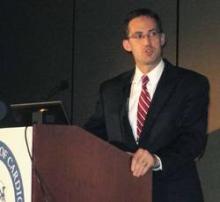SAN FRANCISCO – Women with atrial fibrillation have significantly more debilitation than men with the disorder, but men with atrial fibrillation have double the cardiovascular death rate than their female counterparts, based on data collected from more than 10,000 U.S. patients.
During follow-up of the 5,842 men and 4,290 women with atrial fibrillation who were enrolled in the registry, women’s cumulative rate of cardiovascular death lagged 54% behind men’s, a statistically significant difference, Dr. Jonathan P. Piccini reported at the annual meeting of the American College of Cardiology.
The rate of all-cause death ran a relative 31% lower in women compared with men, but this difference seemed mostly due to the cardiovascular-death disparity because rates of noncardiovascular deaths in women and men with atrial fibrillation were virtually identical, said Dr. Piccini, an electrophysiology cardiologist at Duke University in Durham, N.C.
Despite this survival advantage, women with atrial fibrillation fare worse than men by several other measures. Women report worse symptoms, more functional impairment, and worse quality of life; they also spend significantly less time in their target anticoagulant range and they have a higher stroke risk than men, he reported.
"When we see women with atrial fibrillation, we should be aware that they are more likely to have worse symptoms and quality of life. Symptoms need to be treated; when a patient persists in having symptoms, treatment to control the symptoms is very important," he said in an interview. "We need to investigate the registry data to see why women have more symptoms and worse quality of life. This is the largest quality of life study ever done in atrial fibrillation."
Among the 10,132 patients enrolled in the registry, 1,339 participated in a substudy that serially measured quality of life using the Atrial Fibrillation Effect on Quality of Life (AFEQT) questionnaire (Circ. Arrhythm. Electrophysiol. 2011;4:15-25). "We have the power to look at the effects of different treatments so we can assess how changing treatment affects quality of life," Dr. Piccini said.
The Outcomes Registry for Better Informed Treatment of Atrial Fibrillation (ORBIT AF) enrolled both prevalent and new-onset atrial fibrillation patients at 184 diverse practice settings, including primary care, cardiology, and electrophysiology offices, between June 2010 and August 2011. The enrolled men were an average of 73 years old, while the women averaged 77 years of age.
Coronary disease was present in 39% of men and 23% of the women, but 17% of the women had a history of stroke or transient ischemic attack, compared with 14% of the men. Both sexes had a similar distribution of atrial fibrillation type, but women had clearly higher CHADS2 scores, a measure of stroke risk. The percentage of patients with a score of 0 or 1, the lowest-risk patients, was 33% among men and 23% among women.
Every symptom assessed was more common among women, led by the most frequent symptom, palpitations, which affected 40% of women and 27% of men. The next most common symptoms – exertional dyspnea, fatigue, and lightheadedness – were each several percentage points more common in women than men, all statistically significant differences.
Reassuringly, use of rate and rhythm-control treatments and oral anticoagulation were very similar among men and women, but women more frequently had a prolonged gap between their anticoagulation checkups, and their time spent within the target international normalized ratio of 2.0-3.0 was 65%, significantly below the 68% rate in men.
The rate of new heart failure during follow-up was the same in the men and women. Women had higher stroke risk based on their CHADS2 scores, but their stroke rate, while numerically greater than in men, was not significantly higher.
AFEQT results from the registry subset showed that women had significantly worse (lower) scores than men overall and for each of four AFEQT component scores tallied at both baseline and 1-year follow-up: symptoms, daily activity, treatment concern, and treatment satisfaction.
The ORBIT AF registry is sponsored by Janssen. Dr. Piccini said that he has financial relationships with Boston Scientific, GE Healthcare, Janssen, Johnson & Johnson, Medtronic, and Pfizer Bristol-Myers Squibb.
On Twitter @mitchelzoler



